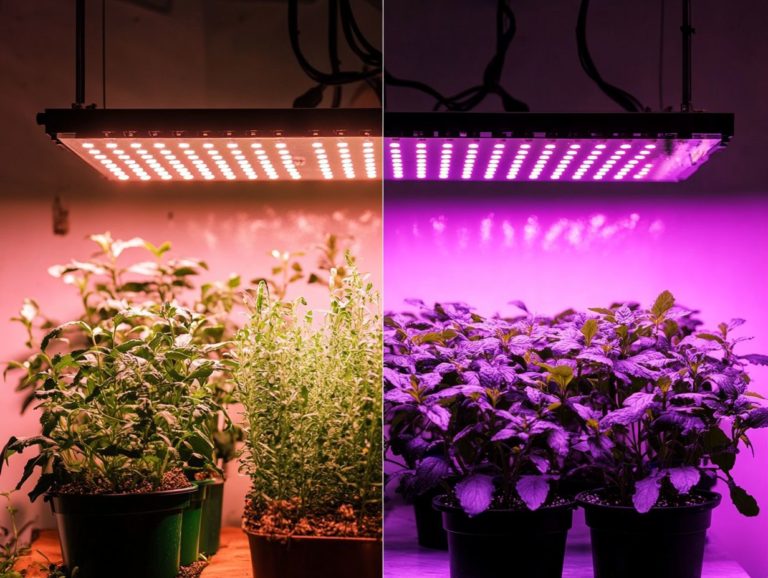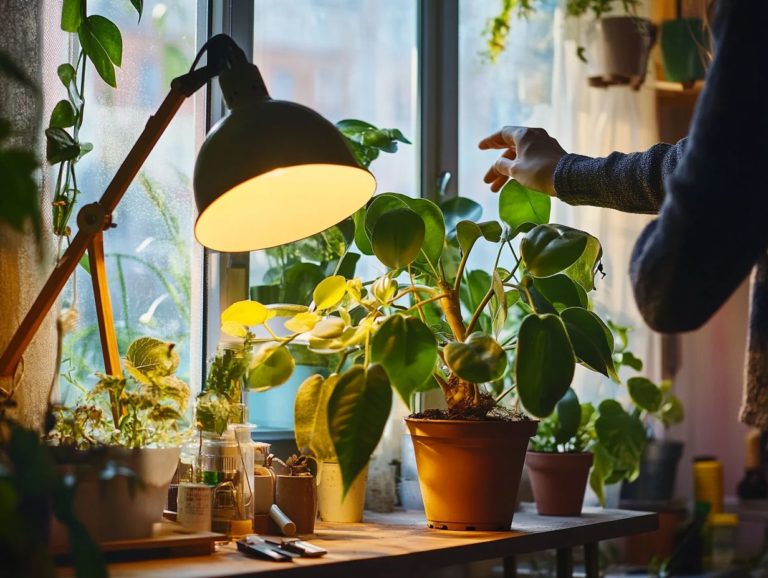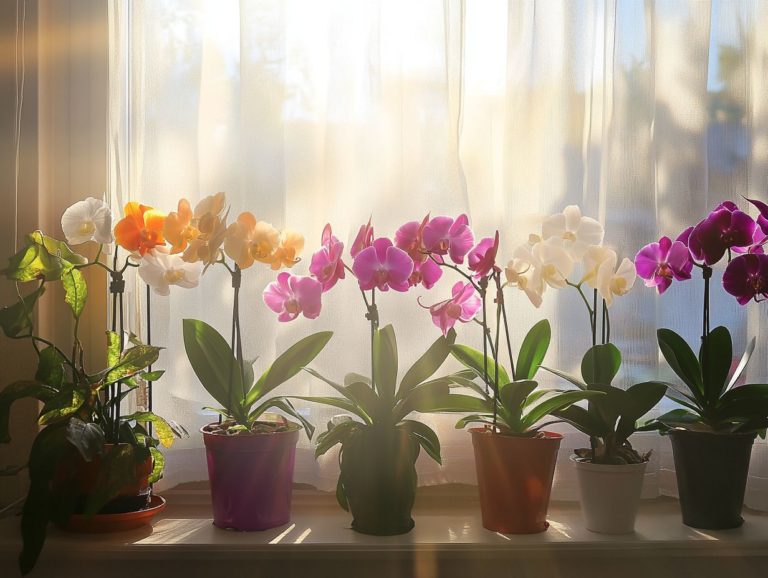Lighting Considerations for Plant Growth
Plants flourish under the influence of light, which is essential for their growth and development.
This article delves into the critical role that light plays in photosynthesis. It examines how various types of light both natural and artificial affect plant health, leading to healthy foliage and vibrant blooms.
You will discover key considerations when choosing lighting based on plant species and their light requirements. We will also cover methods to measure light intensity for optimal growth.
From tackling common lighting challenges to establishing the ideal setup for seedlings and flowering plants, this guide has everything you need to create your perfect green space.
Contents
- Key Takeaways:
- The Importance of Light for Plant Growth
- Types of Light for Plant Growth
- Key Factors for Choosing the Best Lighting
- How to Measure Light for Optimal Growth
- Lighting Set-Up for Different Stages of Plant Growth
- Troubleshooting Common Lighting Issues
- Frequently Asked Questions
- What are the most important lighting considerations for plant growth?
- What types of light are best for plant growth?
- How does light intensity affect plant growth?
- What is the ideal light duration for plants?
- Do plants need different types of light at different stages of growth?
- Can using the wrong lighting affect plant growth?
Key Takeaways:
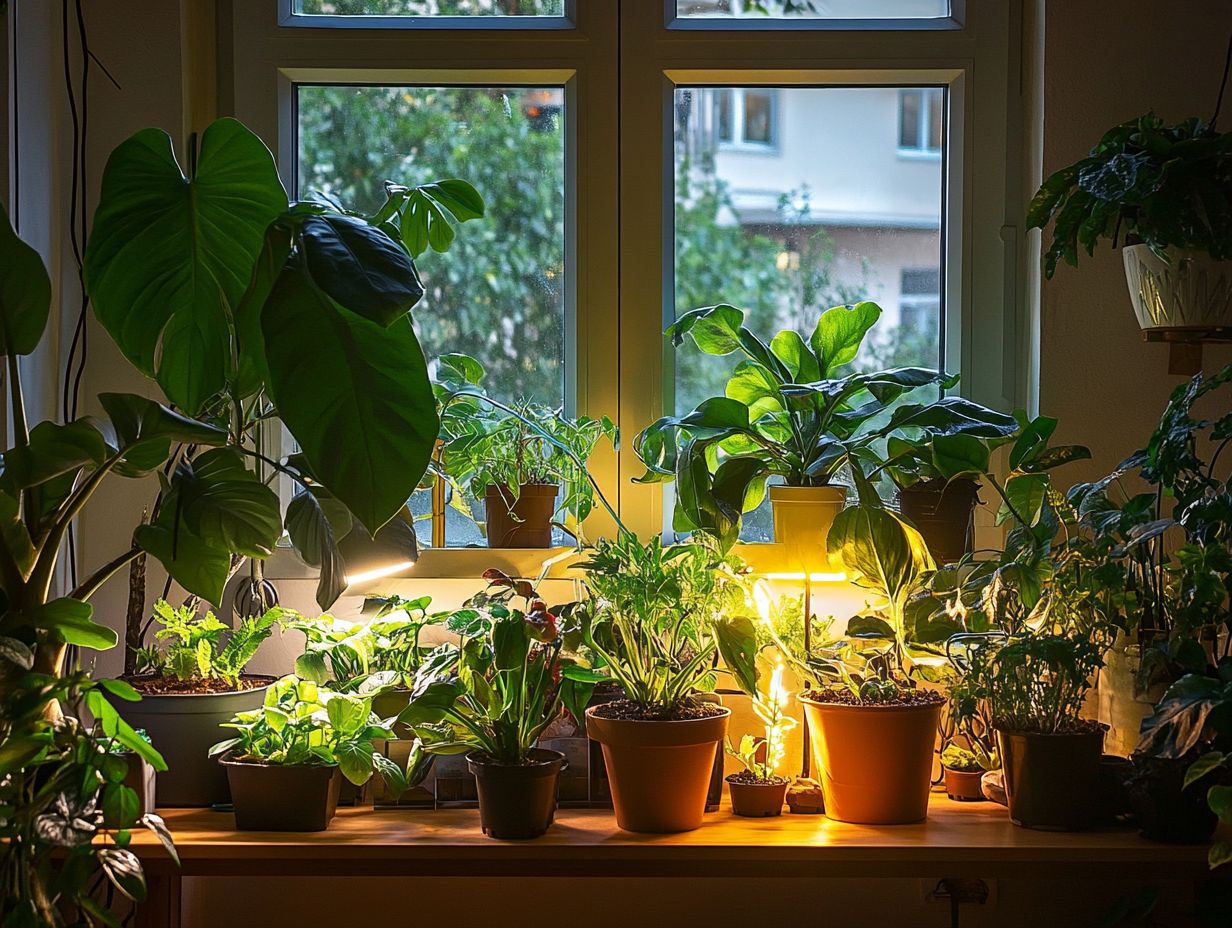
- Light is essential for plant growth as it is the main source of energy for photosynthesis.
- Natural and artificial light can be used for plant growth, but understanding different wavelengths is crucial for optimal results.
- When choosing lighting for plants, consider their specific light requirements, including low-light, medium-light, and high-light classifications, as well as whether they will be grown indoors or outdoors.
The Importance of Light for Plant Growth
Light is fundamental to plant growth. It also improves your environment, making indoor spaces feel lively and fresh.
Plants use light energy to make food through a process called photosynthesis. This process converts light energy into chemical energy, fostering robust foliage and vibrant blooms.
Various types of light, including natural sunlight and artificial sources like LEDs, fluorescent, and incandescent grow lights, deliver the necessary spectrum and intensity for optimal plant metabolism. This ensures robust energy reserves for healthy growth.
Role of Light in Photosynthesis
The role of light in photosynthesis is essential. You can see how plants convert sunlight into usable energy through chlorophyll.
This remarkable pigment captures light energy, primarily from the blue and red wavelengths. This energy is transformed into chemical energy during the light-dependent reactions, which occur in the thylakoid membranes of chloroplasts. Here, water molecules are split, releasing oxygen as a byproduct.
You can’t underestimate the importance of light quality. The specific wavelengths available can dramatically affect the rate of photosynthesis.
Light duration, also known as photoperiod, is critical for plant productivity and growth. This emphasizes the need for balanced light exposure to optimize photosynthetic efficiency, ensuring that every moment of light is leveraged for the best possible outcome.
Types of Light for Plant Growth
Understanding the various types of light available for plant growth is crucial for optimizing their development. This includes utilizing natural sunlight as well as exploring an array of artificial lighting options, such as LEDs, fluorescent, and incandescent grow lights.
Each type plays a distinct role in promoting healthy plant growth, including the use of correct light fixtures to maintain optimal conditions.
Natural vs Artificial Light
Natural light, especially sunlight, is often your best ally for plant growth. It provides a full spectrum and impressive energy output.
Consider this: sunlight provides all the wavelengths essential for efficient photosynthesis, allowing your plants to flourish by harnessing both visible and ultraviolet light.
On the other hand, artificial light offers flexibility and control, especially when cultivating indoor gardens. It can be customized for specific growth stages, enabling you to optimize energy use and select targeted wavelengths that truly boost plant health, as detailed in the science of light and plant care.
While the consistent nature of natural light creates a stable growth environment, the role of natural light in plant growth complements artificial systems that ensure your plants receive the right intensity year-round, maximizing productivity. By recognizing the unique advantages of each lighting type, you can make informed decisions about the most effective solutions for your specific plant needs.
Understanding Different Wavelengths
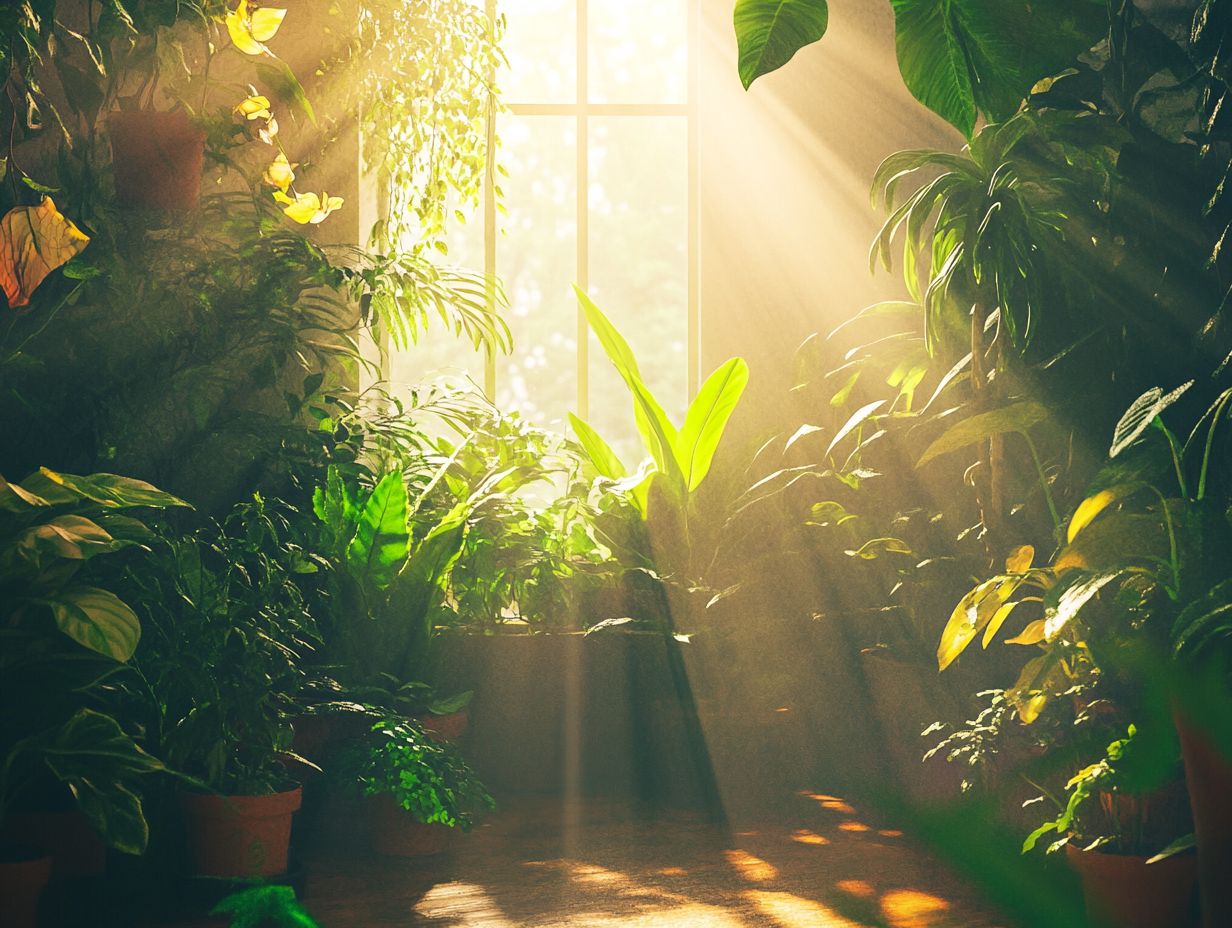
Different wavelengths of light each play unique roles in your plants’ growth, with chlorophyll primarily absorbing blue and red wavelengths essential for photosynthesis and energy production. This absorption helps plants take in nutrients and grow.
Other wavelengths within the light spectrum also influence plant behaviors, including germination and flowering cycles. For example, far-red light can encourage stem elongation, helping your plants stretch their way toward the light source.
By understanding how these wavelengths interact with chlorophyll, you unlock intriguing possibilities for optimizing growth conditions, enhancing yield, and improving resilience to environmental stressors. Learning about light quality for plants can help you with the careful manipulation of artificial lighting techniques, creating the ideal conditions that maximize output sustainably.
Key Factors for Choosing the Best Lighting
Choosing the right lighting for your plants requires a keen understanding of their specific light needs, including light intensity, duration, and whether the setting is indoor or outdoor. By tailoring the lighting to each plant species, you can create an optimal environment for growth and vitality.
Plant Species and Light Requirements
Different plant species come with distinct light requirements, categorized into low-light, medium-light, and high-light plants. These classifications play a crucial role in their growth, energy reserves, and overall health.
- Low-light: Consider the low-light champion, the Snake Plant. It thrives in the gentle embrace of indirect sunlight, flaunting thick, fleshy leaves that store moisture, allowing it to thrive even in darker corners.
- Medium-light: The Peace Lily flourishes in filtered light and can handle a dash of direct sun. Their broad leaves maximize photosynthesis while cleverly minimizing water loss.
- High-light: Plants such as succulents and certain cacti demand full sun exposure. They have thick, waxy coatings that help reduce evaporation and store hydration, making them tough contenders in harsh conditions.
Indoor vs Outdoor Growing
Indoor gardeners face unique challenges with artificial lighting due to limited access to natural light, while outdoor gardening thrives on sunlight but might need extra lighting during low-light seasons.
You’ll need to carefully manage the light spectrum and duration to mimic the natural growth conditions that outdoor plants flourish in.
On the flip side, outdoor environments enjoy the full spectrum of sunlight, crucial for photosynthesis, yet they face fluctuating weather, seasonal changes, and pests that can disrupt plant growth during dark hours.
Recognizing these lighting differences is crucial for your gardening success. It highlights the importance of selecting the right plants tailored to their respective environments, ensuring optimal health and impressive yield for your gardening endeavors. For more insights, explore the impact of light on plant health.
How to Measure Light for Optimal Growth
Measuring light is essential for guaranteeing optimal growth in your plants. By employing special tools that measure light, you can accurately assess light intensity through metrics like PPF (Photosynthetic Photon Flux) and PPFD (Photosynthetic Photon Flux Density). PPF measures the total amount of light available for photosynthesis, while PPFD shows how much light reaches a specific area.
This meticulous approach gives you the power to create the ideal lighting conditions that foster robust plant health and vibrant development.
Tools and Techniques for Measuring Light Intensity
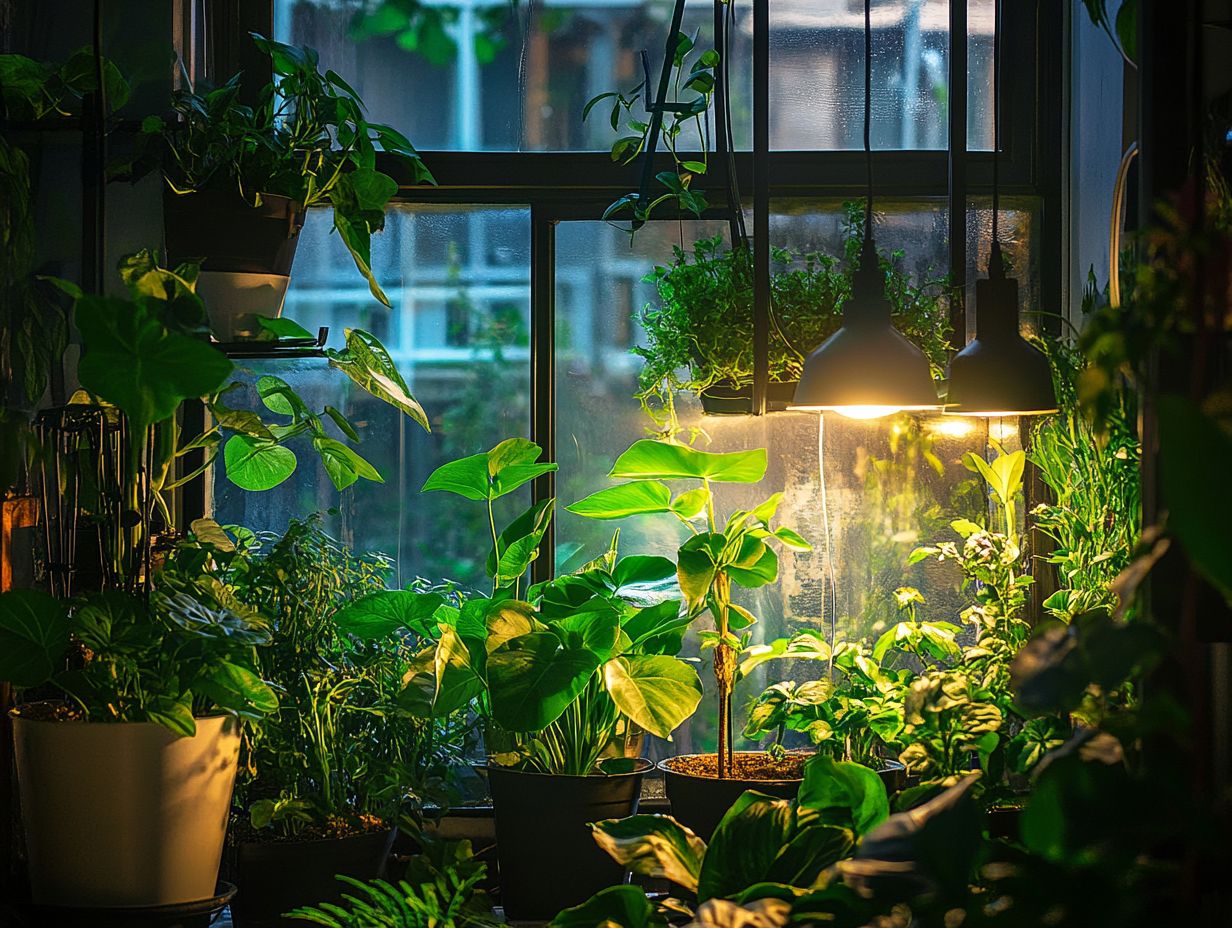
Tools and techniques for measuring light intensity at your disposal include light meters specifically calibrated for Photosynthetic Photon Flux (PPF) and Photosynthetic Photon Flux Density (PPFD). These devices enable you to accurately assess both the quality and quantity of light available for your plants.
Beyond light meters, photodetectors and quantum sensors are essential for obtaining precise readings. These sophisticated instruments measure the light plants use for photosynthesis and quantify overall light distribution.
If you garden indoors or in a greenhouse, it’s important to understand these measurements. Optimal light intensity directly influences photosynthesis, impacting plant health. By employing these advanced tools, you can tailor light conditions to meet the unique needs of various plant species, promoting strong growth and significantly enhancing productivity in your agricultural endeavors. For more detailed information, check out our guide on understanding indoor plant light needs.
Lighting Set-Up for Different Stages of Plant Growth
An effective lighting setup is crucial for the various stages of plant growth. You need to customize light durations and intensities for seedlings, vegetative growth, and flowering phases to ensure your plants achieve optimal health and productivity.
Seedlings, Vegetative Growth, and Flowering
Seedlings thrive under gentle light, which is essential for their healthy establishment. As they transition into the vegetative phase, the demand for higher light intensity increases to support robust leaf development. In terms of the flowering stage, specific light conditions become vital to optimize energy storage and flowering potential.
Understanding these distinct lighting needs is key to ensuring the optimal growth and health of your plants throughout their lifecycle. For your seedlings, providing soft, indirect light allows them to establish strong roots without overwhelming their delicate nature.
As they move into the vegetative phase, ramping up the light intensity encourages vigorous foliage growth, crucial for photosynthesis and overall vitality.
In the flowering stage, fine-tuning both light duration and intensity not only enhances blooming but also boosts the plant’s ability to store energy, ultimately paving the way for a more bountiful harvest. By adapting these lighting strategies, such as using smart lights for plant care, you can effectively nurture your plants at every stage of their development.
Troubleshooting Common Lighting Issues
Is your plant looking a little off? Let’s tackle some common lighting issues! Troubleshooting these problems is essential for preserving plant health. You’ll want to be vigilant in identifying signs of light burn, light deficiency, and light stress, as these factors can profoundly affect overall growth and vitality.
Light burn shows as scorched leaves, while light deficiency causes leggy growth and yellowing foliage both clear signals that adjustments to light conditions are necessary to ease the stress on your plants. These issues usually come from too much or too little exposure.
When your plants bask in direct sunlight for too long, they may experience light burn, evident in crispy leaf edges or unsightly browning. On the flip side, insufficient light causes them to stretch desperately towards the nearest source, resulting in spindly stems and lackluster colors.
To combat light burn, relocating your plant to a location with filtered light or adjusting its lighting duration can work wonders. If light deficiency is the culprit, consider incorporating grow lights to provide a controlled and steady energy source, ensuring your foliage remains lush and vibrant.
Regularly monitoring light intensity and maintaining appropriate distances from light sources will help you sustain optimal conditions and minimize plant stress.
Frequently Asked Questions
Here are some common questions that can help you optimize your plant lighting.
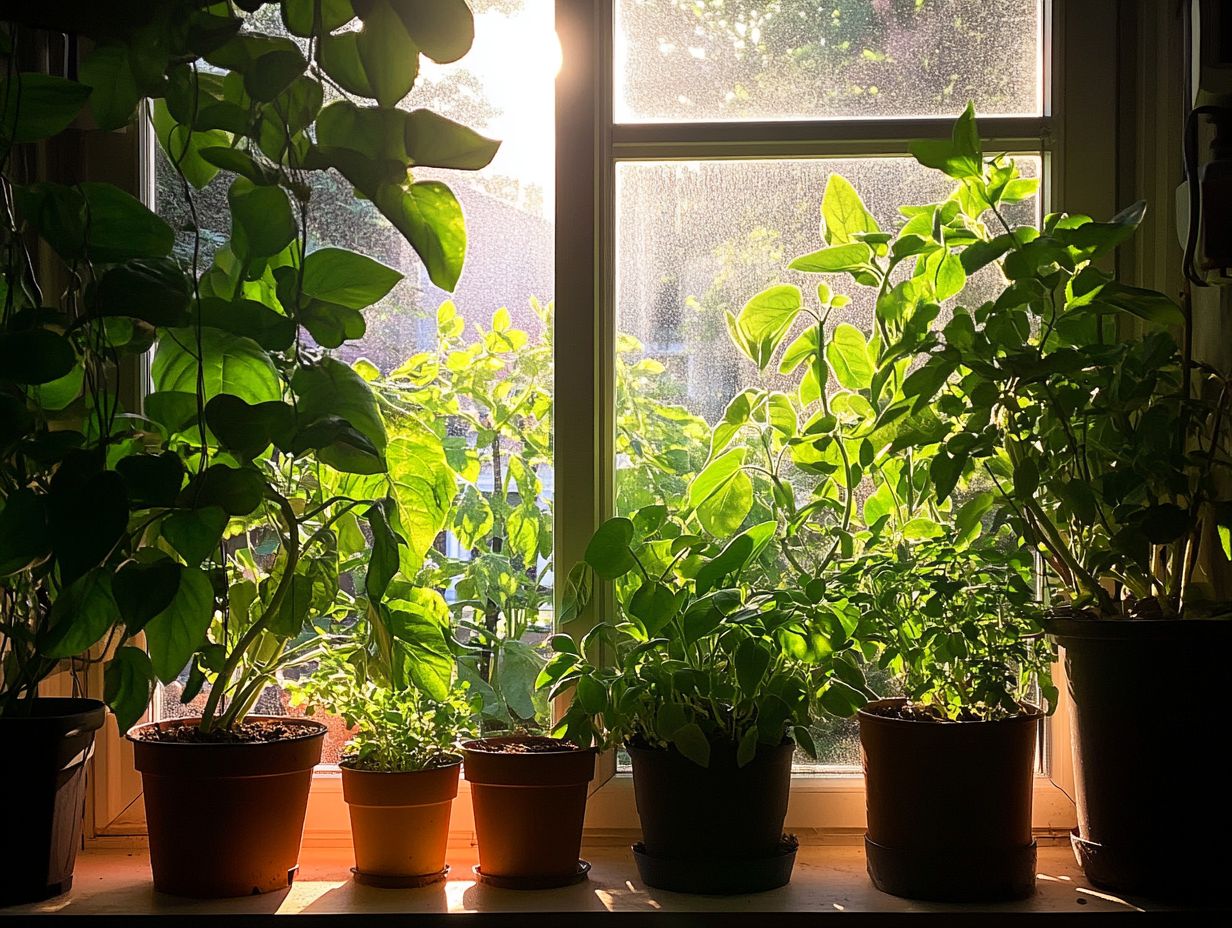
What are the most important lighting considerations for plant growth?
Light intensity, duration, and color spectrum are crucial for plant growth. Plants need enough light for photosynthesis, the way they make food from light, the right amount of time in the light, and a balanced color spectrum to grow well.
What types of light are best for plant growth?
Natural sunlight and artificial grow lights are the best options. Sunlight offers a full spectrum of light, while artificial lights can be adjusted for different plants’ needs.
How does light intensity affect plant growth?
Light intensity directly impacts how well plants grow. If there isn’t enough light, plants can become weak and pale; too much light can burn their leaves.
What is the ideal light duration for plants?
The ideal light duration varies by plant type and growth stage. Most plants thrive with 12-16 hours of light each day, but some may need more or less depending on their specific needs.
Do plants need different types of light at different stages of growth?
Plants need different light types as they grow. In the vegetative stage, blue light supports leaf growth, while red light is best during flowering to encourage blooms and fruits.
Can using the wrong lighting affect plant growth?
Using the wrong light can harm plants significantly. Not enough light can make them weak, while too much can cause burns. Choosing the right light type is essential for healthy growth!

